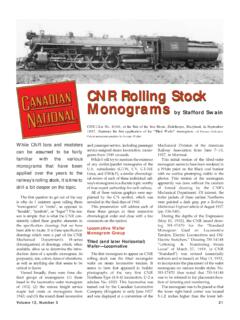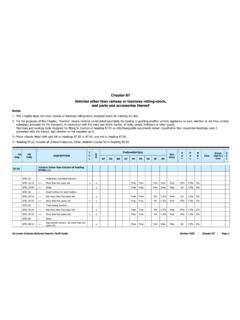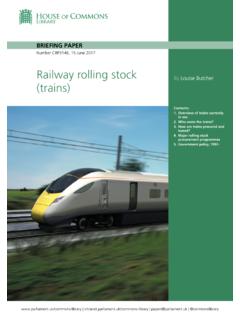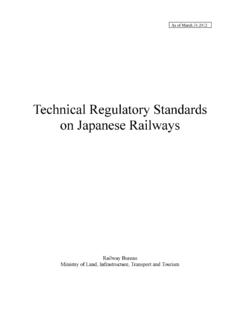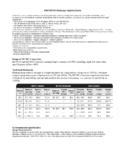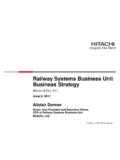Transcription of CHAPTER-II FINANCIAL APPRAISAL OF RAILWAY PROJECTS
1 CHAPTER-II FINANCIAL APPRAISAL OF RAILWAY PROJECTS 201- 202 General Principles 203 Scrutiny by Accounts officer 204-205- 206-207 Test-of Remunerativeness 208 - 209 Provision of Rolling Stock 210 Scheme for change of traction 211-212- 213-214 Earnings estimate 215-217 Assessment of working expenses 218 Provision for depreciation 219 Normal Lives of assets 220 Technique of FINANCIAL APPRAISAL of PROJECTS 221-222 Accounting rate of return method 223-224 Pay back period method. 225 Discounted cash flow 226-227 Net present value (NPV) or Net Present Worth (NPW)
2 228 Annual Cash Flows 229-230- 231-232 Rate of return under 233 Residual Value 234 Alternative Schemes 235 Economic Evaluation 236 - 237 Replacements and Renewals 238 Reconditioning 239 - 240 Scrapping, condemning and abandoning assets 241 - 242 Second hand value 243 Post- PROJECTS APPRAISAL 244 - 247 New Lines 248 - 252 Open Line Works ANNEXURE Annexure A Check list with detailed notes for guidance of zonal railways and concerned branches in RAILWAY Board's office, in the preparation of project Estimates. Annexure B Sinking fund Payment Table Annexure C Interest formulas and tables for Discounted Cash flow techniques Table 1 -22 Table 1, Table 2 , Table 3 , Table 4 , Table 5 , Table 6 ,Table 7 , Table 8 , Table 9 , Table 10 , Table 11 , Table 12 , Table 13 , Table 14 , Table 15 , Table 16 , Table 17, Table 18 , Table 19 , Table 20 , Table 21 and Table 22 Annexure D Rate of return-using Discounted Cash Flow method.
3 Annexure E Examples illustrating application of DCF techniques in the FINANCIAL APPRAISAL of RAILWAY PROJECTS . Annexure F Economic evaluation of RAILWAY investments Annexure G Examples illustrating the method of FINANCIAL justification to be adopted in the replacement, reconditioning or abandonment of existing assets Annexure-H . Examples, illustrating the determination of second hand value of assets . ** CHAPTER II FINANCIAL APPRAISAL OF RAILWAY PROJECTS 201 General Principle.
4 - Investment decisions are among the most interesting and difficult decisions to be made by the Managements. It is fundamental to RAILWAY system as a commercial undertaking that expenditure other than that wholly chargeable to Ordinary Revenue incurred on new assets or for improvement of existing assets should be financially justified and sanctioned before it is actually incurred. 202 As an exception to Para 201, while no FINANCIAL justification as such need be given in the following cases, it should be seen that the scale of expenditure incurred is as economical as possible consistent with the extant orders, if any, on the subject:- (a) when the expenditure is incurred on a statutory obligation (for example, the fencing of machinery) ; (b) when the expenditure is unavoidable on considerations of safety; (c) when the expenditure is incurred on passenger amenity works.
5 And (d) When the expenditure is incurred on labour welfare works except residential buildings for which special rules are applicable. Note:--(1) When expenditure on any of the above items forms part of a scheme and is not essential independently of the scheme, the total cost of the scheme, inclusive of the cost of the above works, should be financially justified. (2) In the case of savings in engine days or wagon days or both by avoidance of or reduction in detentions to stock, etc., the FINANCIAL justification should be worked out on the basis of increased locomotive or wagon, etc.
6 , utilization and consequent postponement of the purchase of new engines or wagons, etc., if such saving can be definitely secured, and not on the basis of the earning capacity of the stock saved. (3) Savings on a particular RAILWAY should not be taken into account if they mean a loss on another RAILWAY . In such cases, the interest of railways as a whole should be considered. (4) No credit should be given to a proposed scheme for a saving which can be achieved regardless of whether the proposed scheme is or is not embarked upon.
7 (5) If flag stations are included in the new scheme, the cost of operating them should be taken into account as an item of expense in working out the FINANCIAL justification of the scheme. (6) Where a number of works required in connection with and/or increasing the line or transhipment capacity have to be carried out on different stations of a section as part of a scheme, the FINANCIAL justification should be worked out for the section as a whole, as it might be difficult to allocate anticipated savings to individual stations.
8 (7) Expenditure on works required for meeting statutory obligations or on consideration of safety should be subjected to proper scrutiny to see if the proposal is the result of a fresh development not already covered by the existing rules, or for implementation of a new recommendation of the Standing Safety Committee (accepted by the competent authority) or any Commission of Enquiry set up by Government, as the case may be. 203 Scrutiny by Accounts Officer -The Accounts Officer in his position as the FINANCIAL Adviser to the Administration, should carefully scrutinise the justification for proposed expenditure with reference to the principles enunciated in this Chapter and other orders on the subject.
9 Even in cases where the return on the outlay is not the determining factor, it will be incumbent on him to examined and offer his advice on the general merits of the proposal in the spirit of a prudent individual spending his own money. 204 Test of Remunerativeness -The net FINANCIAL gain expected to accrue from a project may be either by way of savings in expenditure or increase in the net earnings ( , gross earnings less working expenses), or a combination of both. Except in the case of residential buildings, assisted sidings and rolling stock to which special rules are applicable, no proposal for fresh investment will be considered as financially justified unless it can be shown that the net gain expected to be realised as a result of the proposed outlay would after meeting the working expenses or the average annual cost of service (see para 217)
10 , yield a return of not less than 14 per cent under DCF method or per cent under the conventional method on the initial estimated cost. (Authority RAILWAY Board s file No. F(X)-II/87/FSC/l dt. ) ACS Note- (1) Interest during construction should be added to the cost (excluding that chargeable to Revenue) of the PROJECTS , the construction of which is likely to last for more than one year. (2) Depreciation should be calculated on the total cost of the scheme and not only on the portion chargeable to Capital, unless the contrary procedure can be justified in any particular case.










